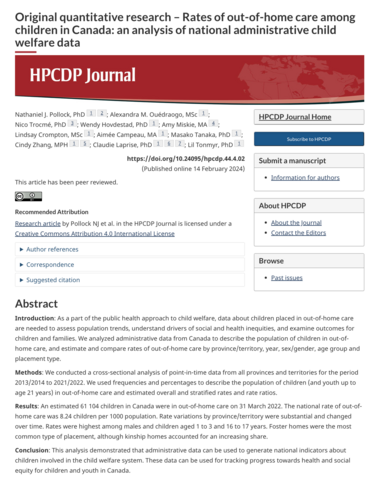Abstract:
Introduction:
As a part of the public health approach to child welfare, data about children placed in out-of-home care are needed to assess population trends, understand drivers of social and health inequities, and examine outcomes for children and families. The authors analyzed administrative data from Canada to describe the population of children in out-of-home care, and estimate and compare rates of out-of-home care by province/territory, year, sex/gender, age group and placement type.
Methods:
The authors conducted a cross-sectional analysis of point-in-time data from all provinces and territories for the period 2013/2014 to 2021/2022. We used frequencies and percentages to describe the population of children (and youth up to age 21 years) in out-of-home care and estimated overall and stratified rates and rate ratios.
Results:
An estimated 61, 104 children in Canada were in out-of-home care on 31 March 2022. The national rate of out-of-home care was 8.24 children per 1000 population. Rate variations by province/territory were substantial and changed over time. Rates were highest among males and children aged 1 to 3 and 16 to 17 years. Foster homes were the most common type of placement, although kinship homes accounted for an increasing share.
Conclusion:
This analysis demonstrated that administrative data can be used to generate national indicators about children involved in the child welfare system. These data can be used for tracking progress towards health and social equity for children and youth in Canada.

